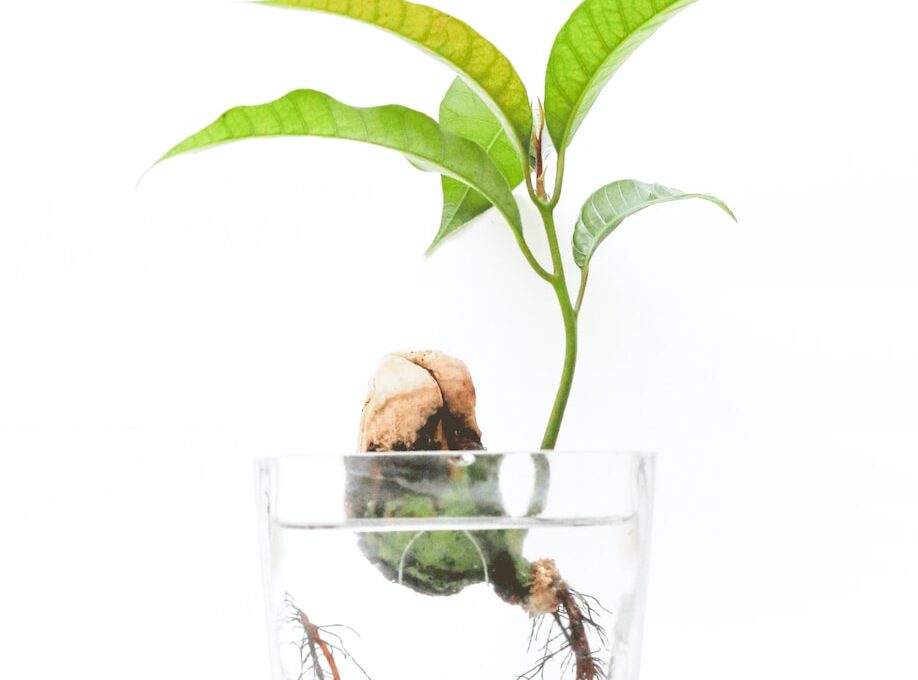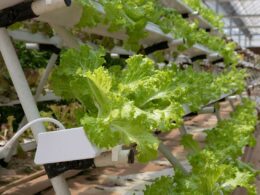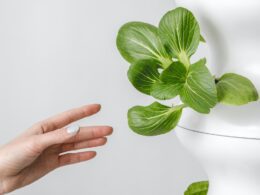Are you worried that your lettuce is being overwatered? It’s important to know the signs of overwatering so you can prevent damage to your plants and ensure healthy growth.
Overwatering can lead to root rot, stunted growth, and even death in extreme cases. In this article, we’ll discuss the dangers of overwatering, how to adjust your watering schedule, and how to treat overwatered lettuce.
We’ll also provide tips for preventing overwatering in other plants. By the end of this article, you’ll have a better understanding of what overwatered lettuce looks like and how to avoid this common gardening mistake.
So, let’s dive in and learn more about how to keep your plants healthy and thriving.
Understanding the Dangers of Overwatering
If you drown your leafy greens with too much H2O, you could be putting your plants in peril! Overwatering is a common mistake that many gardeners make.
Signs of overwatering include yellowing leaves, wilting stems, and root rot. When you overwater your lettuce, you are essentially suffocating the roots by depriving them of oxygen. This can severely impact plant growth and even lead to death.
Yellowing leaves are often the first sign of overwatering. As the roots become waterlogged, they are unable to absorb essential nutrients, causing the leaves to turn yellow.
Wilting stems are another indication that your lettuce is getting too much water. When the roots are unable to absorb oxygen, the stems become weak and unable to support the weight of the leaves. If left unchecked, this can lead to the death of the plant.
Overwatering can have a severe impact on plant growth. When the roots are waterlogged, they are unable to absorb essential nutrients, which can stunt growth and even lead to death. Root rot is another danger of overwatering. It occurs when the roots are constantly submerged in water, leading to the growth of harmful bacteria and fungi.
To avoid overwatering, make sure to water your lettuce only when the soil is dry to the touch. By doing so, you can ensure that your lettuce thrives and produces healthy, delicious leaves.
Adjusting Your Watering Schedule
You’ll know when to water your plants by checking the soil moisture level and observing the condition of the leaves. Overwatering lettuce can lead to yellowing leaves, root rot, and stunted growth. To prevent this, it’s important to adjust your watering frequency and use moisture meters to accurately gauge the moisture level in the soil.
Here are four things to keep in mind when adjusting your watering schedule:
- Lettuce prefers moist soil, but not waterlogged soil.
- Water in the morning to allow the leaves to dry off before nightfall, which can prevent diseases.
- Use a moisture meter to check the soil moisture level and water only when necessary.
- Consider the weather and temperature when determining your watering frequency.
Using a moisture meter can take the guesswork out of watering and help prevent overwatering. Simply insert the meter into the soil and it’ll give you a reading of the moisture level. This can help you adjust your watering schedule accordingly and prevent damage to your lettuce plants.
By adjusting your watering schedule and using moisture meters, you can ensure that your lettuce plants receive the right amount of water and avoid overwatering. Keep an eye on the condition of the leaves and use these tips to maintain healthy and thriving lettuce plants.
Treating Overwatered Lettuce
You may be feeling frustrated and worried if your once thriving lettuce plants suddenly start wilting and turning brown, but don’t give up hope! Overwatering can drown the roots of your lettuce and prevent them from getting the necessary nutrients.
The good news is that you can revive your lettuce by draining excess water from the soil. To treat overwatered lettuce, start by removing any standing water from the soil surface. You can use a dry towel or sponge to soak up the excess water.
Then, allow the soil to dry out for a few days before watering again. Make sure to only water your lettuce when the top inch of soil is dry to the touch. If your lettuce plants are severely damaged from overwatering, you may need to take more drastic measures.
Consider transplanting them to a new location with fresh soil, or pruning off any dead or damaged leaves. With a little patience and care, your lettuce plants can recover from overwatering and continue to thrive.
Preventing Overwatering in Other Plants
Want to ensure your plants stay healthy and vibrant? Learn how to prevent overwatering and keep them thriving! Overwatering is a common mistake that many gardeners make, especially when it comes to container gardening. It’s important to understand that plants need the right amount of water to survive, and too much or too little could lead to various problems.
One way to prevent overwatering is by investing in soil moisture meters. These handy tools can help you determine when your plants need watering and when they don’t. Simply insert the meter into the soil, and it’ll provide you with accurate readings of the moisture level. This way, you can avoid the guesswork and ensure that your plants receive the appropriate amount of water.
Another way to prevent overwatering is by checking the soil regularly. You can do this by sticking your finger into the soil, about an inch deep. If the soil feels dry, it’s time to water. If it feels moist, wait a few more days before watering again.
By monitoring the soil moisture levels and adjusting your watering schedule accordingly, you can keep your plants healthy and thriving without overwatering them.
Conclusion and Recap
Now that you know how to prevent overwatering and keep your plants healthy, it’s time to put these tips into action and watch your garden flourish!
Remember the importance of drainage in your plant containers. If your pots don’t have adequate drainage, it’s easy to overwater your plants and drown their roots. Make sure that you have proper drainage holes in the bottom of your pots and that the soil isn’t too compacted.
On the other hand, signs of underwatering can be just as detrimental to your plants. When plants don’t receive enough water, they can wilt, turn yellow, and even drop their leaves. Make sure to check the soil regularly to ensure it’s not too dry. If you stick your finger in the soil and it feels dry up to your first knuckle, it’s time to water again.
In order to keep your plants healthy and happy, it’s important to strike a balance between over and underwatering. Remember the importance of drainage and keeping an eye out for signs of both over and underwatering.
By following these simple tips, you’ll be able to maintain a flourishing garden for years to come.
Frequently Asked Questions
Can overwatering affect the taste of lettuce?
Overwatering lettuce can have negative effects on its nutrients, which can ultimately affect its taste. When you overwater lettuce, the excess water can drown the roots and prevent them from absorbing the necessary nutrients from the soil. This can lead to a reduction in the flavor and texture of the lettuce.
To prevent overwatering, it’s important to make sure the soil is well-draining and to only water the lettuce when the top inch of soil feels dry to the touch. Additionally, using mulch can help retain moisture in the soil and prevent overwatering.
By taking these prevention techniques, you can ensure that your lettuce stays healthy and flavorful.
How long does it take for lettuce to recover from overwatering?
To prevent overwatering, it’s important to understand the signs of overwatered lettuce. Leaves may appear wilted or yellow, and the soil may feel excessively wet.
If you’ve already overwatered your lettuce, don’t worry. Reviving it is possible with some simple techniques. First, make sure the soil has proper drainage. If it’s in a pot, ensure there are holes in the bottom.
Next, reduce the amount of water you give the lettuce and let the soil dry out slightly between waterings. Finally, consider adding some organic fertilizer to the soil to help the lettuce recover.
With these techniques, your lettuce should begin to recover within a week or two.
Can overwatering cause root rot in lettuce?
Overwatering can definitely cause root rot in lettuce, which can be fatal for the plant. Prevention tips include making sure the soil is well-draining and not holding onto excess water, as well as avoiding standing water around the plant.
If you suspect root rot, treatment options include carefully removing the affected roots and replanting in fresh soil, or using a fungicide. It’s important to act quickly to prevent the spread of the rot and potentially save the plant.
By being vigilant and taking proactive measures, you can avoid the negative effects of overwatering and keep your lettuce healthy and thriving.
What are some signs of overwatering in other types of plants?
Recognizing symptoms of overwatering in various plant species is crucial to maintaining a healthy garden. One of the most common signs is yellowing leaves, which can indicate that the plant is receiving too much water and not enough oxygen.
Other symptoms include drooping or wilting leaves, mold or fungus growth, and stunted growth. Prevention measures include identifying the specific water needs of each plant species and adjusting watering schedules accordingly.
It’s also important to ensure proper drainage and avoid watering during periods of heavy rain or high humidity. By taking these simple steps, you can avoid overwatering and keep your plants thriving.
How can I tell if I am underwatering or overwatering my lettuce?
To ensure healthy lettuce growth, it’s important to properly water your plants. Overwatering and underwatering can both have negative impacts on your crops. The key is finding the right balance.
Tips for proper lettuce watering include checking the soil moisture regularly, watering deeply but less frequently, and ensuring proper drainage. Common mistakes to avoid include watering too frequently, using the wrong type of soil, and not adjusting your watering schedule based on weather conditions.
The impact of soil type on lettuce watering needs can vary, with some soils retaining moisture better than others. By following these tips and avoiding common mistakes, you can ensure healthy lettuce growth and a bountiful harvest.
Conclusion
So, there you have it – overwatering can wreak havoc on your lettuce plants! But now that you know what to look for, you can take steps to prevent this and help your plants thrive.
Remember to always pay attention to your soil moisture levels and adjust your watering schedule accordingly. If you do happen to overwater your lettuce, don’t panic – simply let the soil dry out a bit before watering again, and consider adding some organic compost to help improve drainage.
By taking these steps, you can keep your lettuce plants healthy and happy, and avoid the dangers of overwatering.
And who knows, with the right care, maybe you’ll even be able to enjoy a delicious salad made from your own homegrown lettuce!









